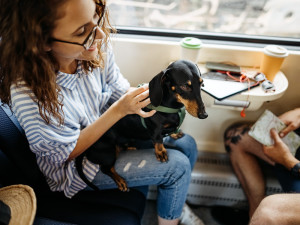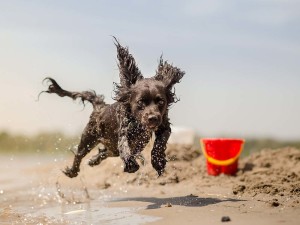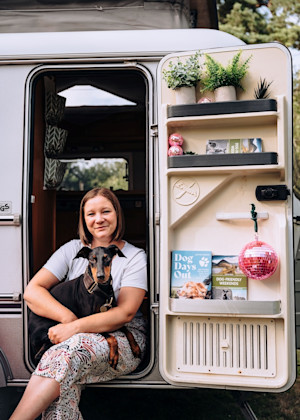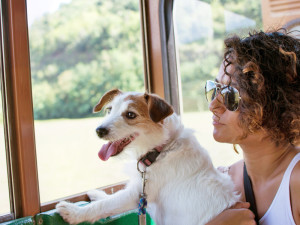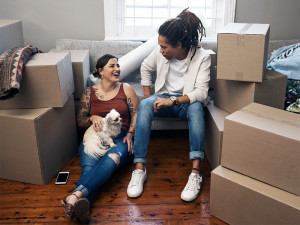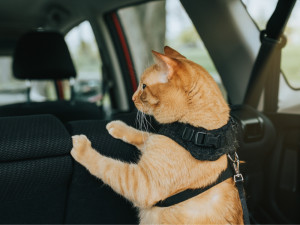Mind the Gap: How to Travel With Your Dog on the Tube
This is a Bark-erloo line service to Maryle-bone
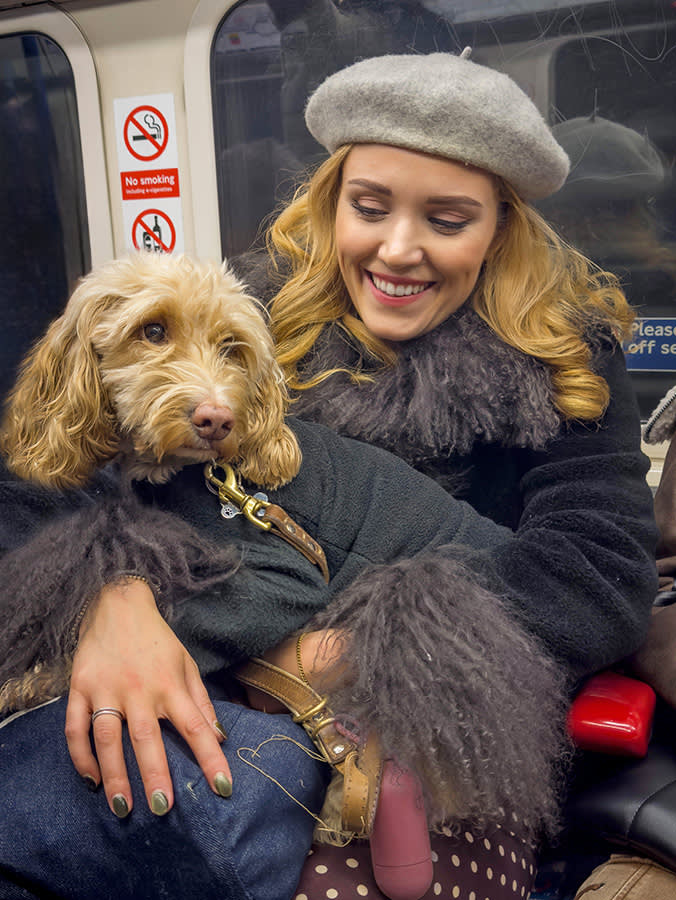
Share Article
In This Article:
Are dogs allowed on the Tube?opens in a new tab Cost to take dog on the Tubeopens in a new tab Preparing your dog for the Tubeopens in a new tab Suitable Tube lines for dogsopens in a new tab Dog etiquette on the Tubeopens in a new tab Stress-free dog Tube travelopens in a new tab Tube travel with mobility-impaired dogopens in a new tab Can dogs go on escalators?opens in a new tab Alternatives to Tube travel for dogsopens in a new tab FAQs about dogs on the Tubeopens in a new tab
Okay, so even from a human perspective, travelling on the Tube in London can feel mildly terrifying – the maps, the escalators, the bodies, the noises, the stress! And, hang on, are we really underground?! So imagine how our dogs feel about city lifeopens in a new tab? Yes, the tube might be dog-friendly, but that doesn’t mean our canine pals automatically know how to navigate their way around it. We must help them; guide them through it. It might just take a little bit of time, patience and planning along the way. Here’s our guide to travelling on the London Underground with your best pooch pal… hopefully they’ll learn that travelling with you on the Tube will always lead to fun adventuresopens in a new tab.
Helping our dogs navigate the human worldopens in a new tab is what we’re here for. And travelling around the capital city’s public transport network is no different. You can’t just take your dog on the Tube and expect them to be okay – you have to help them. This guide is filled with training tips so your dog will be calm and happy, and some helpful tips for planning your journey. Let’s get stuck in.

littleKin™ is Kinship’s home just for puppy and kitten parents. Bop over to check out expert advice, new pet tools, and special deals—all curated for your newest family member.
opens in a new tabAre dogs allowed on the Tube?
All assistance dogs and any other dogs can travel on the Tube. “Unless there is a good reason for us to refuse it – such as if the animal seems dangerous or not properly controlled,” as per TfL’s Conditions of Carriageopens in a new tab.
Is it free to bring dogs on the Tube?
Unlike you, your dog doesn’t need their own ticket to travel on London’s transport network – all dogs travel for free. Yay! More money for treats. However, keep in mind that station staff can refuse entry to your dog if they’re misbehaving. So make sure you’ve got them under control.
How to prepare your dog for a trip on the Tube
If your dog has never been on the Tube, it’s important to prepare them for it. “Go at your dog’s pace, building up in small steps until you take your first proper journey together,” says trainer and behaviour consultant Jennifer Billot @boneballbarkopens in a new tab. “Learn to read your dog’s body language, looking for signs of stressopens in a new tab such as lip licking, yawning, panting and a tucked tail.”
Training tips
Before you even leave your house, get your dog used to the noises they might encounter. “YouTube has lots of sounds related to Tube travel,” says Jennifer. “There are even videos where someone has recorded the entire length of a journey: announcements, doors opening, beeping, crowd noises etc.” Jennifer recommends playing these at low volume while your dog is doing something fun like playing or enjoying an enrichment activity like a Kong or snuffle mat. “If there are no stress signs, start turning the volume up.”
If your dog shows high levels of stress and/or anxiety around tube journeys, it’s important to seek the help of a professionalopens in a new tab. “Dogs rarely just ‘get used to it’,” says Jennifer.
Essential gear
Jennifer recommends using a fixed-length lead, so you can keep your dog by you as you exit and enter the Tube. She describes using a “treat magnet hand” where you hold a high value treat on your dog’s nose and lure them at your side. “Flexi leads, or longer leads, if left too long can get caught in the doors as they close,” warns Jennifer. A smaller breed might be better in a carrier.
How to choose the right route for your dog
The route you take with your dog might take a bit more planning than if you were travelling solo. Use TfL’s journey planneropens in a new tab to put what station you’re travelling from and which is your destination. You can also choose preferences, for example: “use stairs, not escalators” so you don’t have to carry your dog (more on escalators later).
List of Tube lines that allow dogs
Dogs can travel on all Transport for Londonopens in a new tab’s Tube lines. But, warns Jennifer, “not all Tube lines are created equal! There is a massive difference between the open and spacious District Line that spends time above ground, and the cramped and underground Piccadilly line when it’s full of passengers and luggage on the way to Heathrow airport!”
Etiquette for travelling with dogs on the Tube
Your dog must keep under control and on a lead at all times while they are on the Tube. If your dog is not on a lead, they must be in a suitable container. And regardless of your own personal rules at home, your dog must never sit on a seat on the London Underground.
“Making sure your dog feels comfortable at your feet is important,” says Jennifer, who recommends bringing a blanket for them to settle on. “For my own dog, I’ve trained a ‘middle’ cue, which means to sit in between my legs. That way I can protect his paws and tail from other people, and he knows exactly where to be.”
It’s worth remembering too that sadly, not everyone loves your dog as much as you do. If you notice someone backing away, or looking scared, acknowledge that by moving away – if you can – or putting yourself between the person and your dog.
It’s also important to advocate for your dog too – because, of course there will always be fellow passengers who are delighted by the presence of a dog. Maybe they will try to pat your dog on the head or crouch into their space to stroke them, with all the other smells and stresses going on in a busy environment, it might be best to ask them to back off. No one has the right to touch your dog.
Tips for a stress-free trip on the Tube
If there are other dogs or loud children on the Tube, your dog might be feeling uncomfortable. “You can always get off at the next station,” says Jennifer. “There is nothing wrong with getting off at the next stop, taking a breath, letting your dog sniff around to relax, then getting on to the next carriage when it’s quieter and emptier.”
Avoid peak times
Peak times are between 6.30am and 09.30am, and between 4pm and 7pm, so those are the times when the Tube network is at its busiest. “Travel outside of rush hour times,” recommends Jennifer – or at least until your dog is used to it and you’re happy they’re not going to get stressed or accidentally trodden on by fellow passengers.
Start with shorter trips
Before you take your dog on the Tube, get them used to the environment by simply hanging out at the entrance of a Tube station. “Rewarding calmness,” says Jennifer. “If your dog is relaxed, you can then move through the gates and spend some time on the platform.”
Once on the platform, observe trains pulling in and out. “There are big gusts of wind as trains approach, which can make dogs feel uncomfortable so get lots of high value treats ready, a chew or something lickable like dog-safe peanut butter or Primula cheese,” says Jennifer.
For their first ever trip, Jennifer recommends travelling only one stop. “I’d walk my pup to the District Line,” says Jennifer, “then take the Tube for one stop, and walk back. Keeping exposures short and positive so as not to overwhelm him. I gradually increased this over time, adding more stops.”
Pack treats and water
We probably don’t need to tell you that snacks always make a journey more fun. Well, your dog feels the same. Also make sure you have water for them to drink as it can get hot down there.
Bring poo bags
Always bring a stash of poo bags for any unfortunate mishaps. We’re sure they’re not the only ones who’ve been caught short. If it happens, simply pick up the poop and move on – there’s worst things! And we’re sure the Tube has seen it all before…
What to do if your dog has mobility issues
If your dog has mobility issues, choose stations with “step-free access” meaning it’s seamless to step on and off Tube carriages and there are lifts or ramps you can use – or a combination of both. You won’t have to navigate escalators or stairs to move between the street and the platform.
Currently, 92 Tube stations, more than 60 London Overground stations and all 41 Elizabeth line stations have step-free access and all DLR stations and tram stops are step-free.
Can dogs go on escalators?
Only trained assistance dogs can stand with their paws on the escalator steps. All other dogs risk getting their fur, nails or skin caught in the moving steps, so that means that you’ll need to carry them while using the escalators.
Try a ‘ready-up’ cue that warns your dog you are about to pick them up – “so the ground doesn’t suddenly disappear under their feet,” says Jennifer. “Practice this outside of the context of the Tube station to ensure your dog is always comfortable with being picked up.”
If your dog is too large to carry, you can ask a member of staff to stop the escalator for you, so you can walk up or down it. They will usually only be able to do this outside of peak times, when the station isn’t busy.
If it’s an option, it’s better to use a staircase or lift.
Alternative ways to travel with dogs in London
Bus and trams
You can also take your dog on TfL’s buses, trams, DLR, London Overground and Elizabeth line services. Some of these options might even be better for your dog as they aren’t underground so they are easier to access and they feel much more open.
Cycling
If you usually cycle with your dog, you can also cycle with your dog around London. The streets are very busy, so choose your route wisely.
Walking
Some Tube stations are so close together that it’s a better option for you and your dog to walk. Plus you get to see the sights and your best pal gets to sniff and pee along the way.
The bottom line: How to take your dog on the Tube
When you enter a Tube station, make sure you use the wide gates so that you and your dog have the time and space to walk through together.
Dogs on the tube: frequently asked questions
Can I take my dog on the Tube?
Dogs are allowed on the Tube but it’s important to consider whether your dog should go on the Tube. “If they are very nervous or stressed, or are fearful of other dogs or children perhaps travelling on the Tube isn’t right for them,” says Jennifer. “It is a tight space with no opportunity to get any distance.” Something called ‘trigger stacking’ can happen in these environments – where lots of stresses build up on top of one another. “There’s a lot of extra steps needed before your dog even steps his paws on the Tube – going through ticket barriers, long tunnels, escalators or lifts, presence of other people, suitcases, announcements etc.” Yep, it’s a lot. So make sure they are ready for it.
What animals can you take on the Tube?
According to TfL’s conditions of carriage, what it describes as “inoffensive animals” can go on the Tube. You most definitely can’t take livestock (leave your pig, sheep or goat at home!) or non-domestic animals on the Tube. Small animals like cats should be carried in a suitable carrier.
Are dogs allowed on trains in the UK?
Dogs are allowed on trains in the UKopens in a new tab, but make sure you check with the provider about any rules or preferred travel times or conditions.
Can you take a dog to London?
Your dog is most welcome to enjoy city lifeopens in a new tab. There are lots of dog-friendly places to stayopens in a new tab, amazing parks to enjoy and sights to see – and sniff!

Alice Snape
Alice Snape is a freelance writer and editor whose work has featured in Cosmopolitan, Metro, Red, Vice, amongst other publications. Her rescue dog Lucy is the love of her life – probably because she’s an anxious weirdo like her. You’ll likely find them both curled up in bed – Alice’s favourite place to write from – or out having an adventure together in the park…
Related articles
- opens in a new tab
How Can I Get a Pet Passport in the UK?
Don’t start packing those treats just yet...
![Dog running on the beach]() opens in a new tab
opens in a new tabCan I Take My Anxious Dog On Holiday?
Think a holiday with your nervous pup is off-limits? You just need to make a few adjustments. Here’s how to have a dreamy trip that you and your anxious dog can enjoy
![a woman and a man sit in an empty home surrounded by boxes with a dog]() opens in a new tab
opens in a new tabMoving Abroad With Your Dog? Here’s Everything You Need To Know
Moving house is stressful at the best of times, but what happens if you want to move abroad with your dog? We consulted some experts to find out
![Cat standing up in the back of a car]() opens in a new tab
opens in a new tabHow to Travel With a Cat (Without a Scratch)
Everything you need to bring your cat home for Christmas, including calming products and a portable litter box
- opens in a new tab
Why Do Dogs Get Car Sick?
Car sickness isn’t just a human problem – it’s also common in dogs. But what causes it, and how can we help them feel better?
